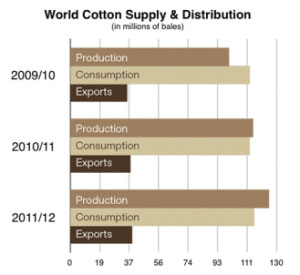Limited Supply, High Prices Stunt Global Cotton Mill Use

Despite the strong projected global economic growth, cotton mill use is expected to remain stable at 24.6 million tons in 2010/11 due to limited available supplies and high prices, according to the International Cotton Advisory Committee.
Global cotton stocks fell by 25 percent in 2009/10 to 41 million bales, the smallest in seven seasons. Ending stocks are projected to increase to 42 million bales in 2010/11. However, this hides disparate geographic trends: stocks are expected to decline in most countries of the Northern Hemisphere and to increase in the Southern Hemisphere due to an expected bumper crop. The global stocks-to-use ratio could increase from 36 percent in 2009/10 to 38 percent in 2010/11, still well below the 10-year average (48 percent).
International cotton prices have risen steeply since the beginning of this season. The average Cotlook A Index over the first four months of the season is 120 cents per pound, almost twice as high as the average over the same period last year. It is also well above the current ICAC 2010/11 season-average projection of 95 cents per pound.
Cotton prices rose much faster than polyester prices over the last few months. This has already resulted in some shifts in fiber blends at the spinning level, to the benefit of polyester. The share of cotton in global fiber use, estimated at 36.5 percent in 2009, will likely continue to decline in 2010 and 2011.








